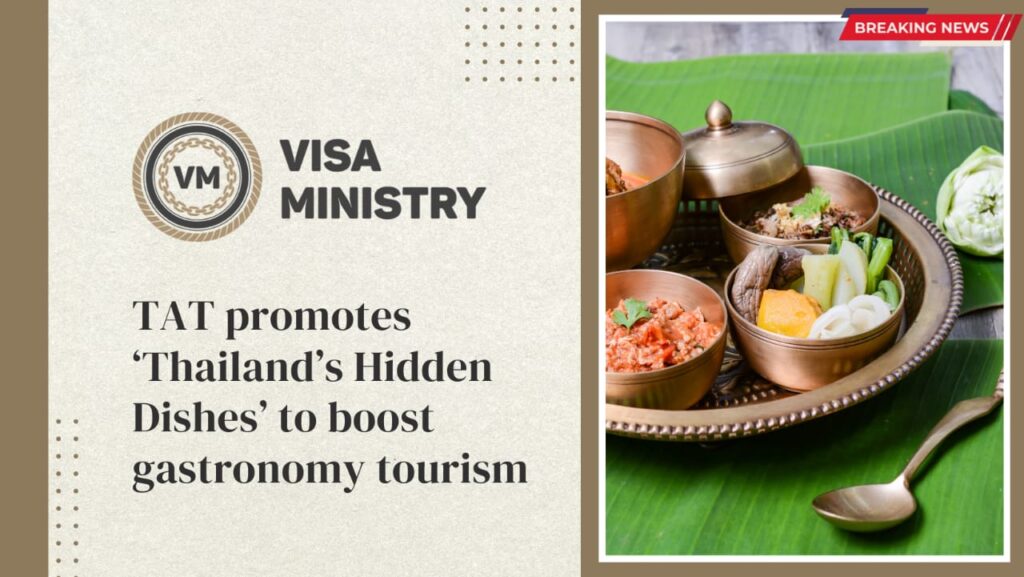Introducing lesser-known speciality cuisines from the five regions of Thailand in an effort to encourage visitors to go on a gastronomic tour of the country.
Thailand – throughout order to capitalise on gastronomy tourism as a pleasurable method for Thai and international visitors to appreciate the diversity of Thai food, the Tourism Authority of Thailand (TAT) is marketing “Thailand’s Hidden Dishes” throughout the five regions of Thailand: Central, Eastern, Northern, Northeastern, Southern, and Regions.
According to Mr Chattan Kunjara Na Ayudhya, TAT’s Deputy Governor for Marketing Communications, “The promotion of ‘Thailand’s Hidden Dishes’ forms part of the TAT’s ongoing strategy to elevate Thailand’s status as a top-tier gastronomy tourism destination and to raise awareness of the variety of local food culture in Thailand. Five lesser-known speciality foods have been chosen through this project to tantalise the palette, encourage visitors to try new dishes, and encourage them to get involved in the community in Thailand. This is also consistent with our strategy of encouraging tourists to find fulfilling travel experiences in Thailand under the banner of “Visit Thailand Year 2023: Amazing New Chapters.”
The five ‘Thailand’s Hidden Dishes’ are some of the lesser-known speciality delicacies that are often only accessible while going to the location. Visitors will be motivated to explore the sights and activities in Phetchaburi, Trat, Chiang Rai, Khon Kaen, and Phatthalung while also sampling local cuisine.
Phetchaburi’s Kaeng Hua Nod, also known as Kaeng Hua Tan or Toddy Palm Curry, is a representative dish of the Central Region. Phetchaburi is known for a number of regional specialties dishes and has received the UNESCO Creative Cities Network (UCCN) label in the realm of gastronomy. Among other things, the province is renowned for producing premium sea salt, key limes, palm sugar, rose apples, pineapples, and bananas.
The Pla Yum Sawat (also known as coral grouper or coral trout) marine aquaculture industry in Trat in the Eastern Region has made the province’s economic fish and speciality cuisine. The fish is delectable and may be used to create a variety of mouthwatering dishes, including sashimi and the spicy soup Tom Yum.
Moo Phat Raak Suu, a stir-fried pork meal with the roots of hooker chives or garlic chives, is a local speciality of Chiang Rai in Northern Thailand and is an ethnic Thai dish with Yunna culinary influences. The roots of the chives, which are prized for their therapeutic properties and vital nutrients, are also fundamental components of a number of other regional recipes in addition to being stir-fried with pork.
Khon Kaen’s Au Pla, a hot and salty freshwater-fish curry, is a prime example of the flavorful and unusual Thai-Isan cuisine found in northeastern Thailand (or Isan). As a result of the availability of freshwater fish in the several rivers that make up Isan, freshwater fish is a common element in many regional recipes. The MICHELIN Guide Thailand 2023 includes Khon Kaen as one of the four Isan provinces, along with Nakhon Ratchasima, Ubon Ratchathani, and Udon Thani.
The Kaeng Nam Khoei Yod Waai (coconut-based curry with shrimp or fish paste sauce and rattan shoots) is one of Phatthalung’s most well-liked regional specialties. Nam Khoei (shrimp or fish paste sauce), rather than Nam Pla (fish sauce), is a common flavour in southern Thailand. It is a regional speciality food in Phatthalung because it uses Yod Waai, or rattan shoots, which are abundant in the province and have therapeutic advantages.
To raise awareness of the five Thailand’s Hidden Dishes among Thai visitors, TAT collaborated with well-known travel sites on Facebook, including Chinotoshare, Koendanai, Sneakout, Pai Ngai Ma Ngai, and Pai Ka Pai in April 2023. Over a million people were reached by the exposure, and it was projected to contribute roughly 100 million Baht in food and tourist expenditures to the regional economy. FAM tours for worldwide KOLs are among the next initiatives to increase awareness among foreign tourists.
To meet the increased demand from travellers looking for new culinary experiences, Mr Chattan added, “TAT also intends to encourage local restaurants and cafes to incorporate local speciality foods on the menus through the promotion of the Thailand’s Hidden Dishes project.
Source: traveldailynews

